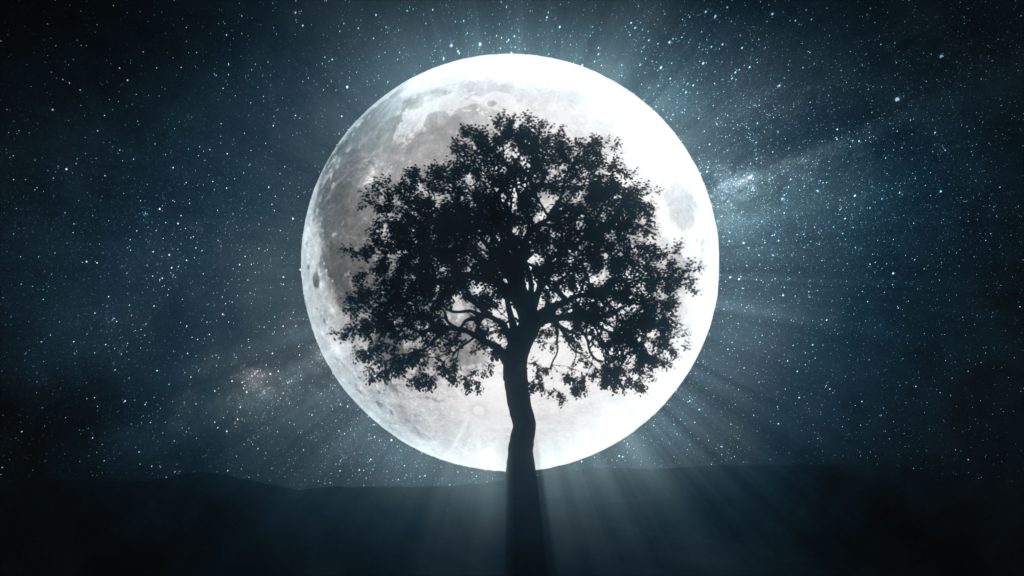
As we explained in the information about CUSP, we use the spiral of the year to bring about long-term, progressive changes throughout the harvest cycle with each successive year building on the foundation laid by the previous years. While this is appropriate for major life changes, there may be times when you need a change to happen on a smaller scale and over a shorter time. Fortunately, nature has provided for this as well.
The sun has long been honored as the strong, bright, and masculine symbol in the sky, but the feminine mysteries are the domain of the cool, silvery moon. Psychology tells us that masculine energy is projective, aggressive, and slow to change. Feminine energy is adaptive, reflective and cycles rapidly.
The solar energy is that of the passion fire, full of action and motion. The moon is the calm reflection that allows us to understand why we do those actions and what the motions mean. It is no wonder our ancestors took note of those innate gender qualities and equated them with these individual heavenly bodies as they did.
Life is complicated and can sometimes come at us quickly. We do not always have time to wait until the harvest to manifest an immediate need. Our yearly harvests are for major life change goals, not just quick and simple changes in our lives. In CUSP, we also work with the cycles of the moon, which allow for manifestation within a month’s time or less, following the ever-present cycles of the moon.
From the first moment that humans looked up into the sky, they felt an intense draw to the ever-changing moon. While the sun offers us assurance and reliability, easing up into the sky each day and dipping behind the horizon every evening, changing the length of the days and nights as the earth moves around it in orbit, the moon reminds us on a more immediate level that all things are transient.
The moon rides its month-long cycle, showing its bright, full face and then gradually turning away again to leave us in the darkness. All faiths have been fascinated by the moon and most have included it in the fiber of their belief system in some form, either in parables, direct worship or even in placing the dates of their major holidays.
Our biological function is very much related to the moon. Many women find that their menstrual cycles are attuned to the cycles of the moon. Gravity is stronger at the time of the Full Moon because of its relative position to the observer and this slightly increased pull can cause a woman who is poised on the brink of childbirth to go into labor as the baby weighs heavier against her ripened cervix. Farmers have, for centuries, worked the fields on the Full Moon because of its bright, generous light during the harvest time of the year.
In CUSP, the moon cycles are the microcosm of what we are doing on a bigger level within the spiral of the year. It begins in the darkness just as December takes us into the first spark of light. The moon progresses to full zenith just as June brings us to the strongest point of the sun. It then slips away, little by little, until we find ourselves in the darkness again, much like the slower progress of the sun into shorter days after Summer Solstice.
Like the sun, the moon shows us that all things work in cycles and that out of the darkness will come light and out of the light will again come darkness. It is a comforting reminder that we are never “stuck” and that movement, even unseen, is always in play, taking us ever forward.
The sun is very prominent and bright in our lives and we are directly dependent upon it for our survival. It boldly provides us with heat and energy, assists our crops in the field to grow and gives our bodies a necessary dose of Vitamin D. Lack of exposure to the sun can even cause illness.
The sun can pleasantly warm us with its rays or just as easily burn us. Modern medicine demonstrates that exposure to ultraviolet light changes the DNA molecules in the body. Over generations, those changes are passed down to offspring. This recent discovery is irrefutable proof that the environment can and does change what we are.
The moon, however, is more gentle and subtle, quietly slipping through its phases. Changes in the character and appearance of the sun occur almost without detection by the naked eye, whereas the moon cycles faster and each night we can note the changes in the moon’s progress.
Lore tells us that each Full Moon has a particular nature that comes with it and for us, that ties into where we also are in the solar calendar. Each moon is a celebration of the point of the year where it occurs, gently encouraging us toward the bigger picture of our overall yearly goal while also assisting us to put energy toward more immediate goals.
Honoring the moon as it moves through its cycles is yet another way of celebrating ourselves and our place in the natural world, as well as honoring the cycles that move through our own bodies and human lifestyle. We can use the shorter cycles of the moon’s phases to achieve positive manifestation in a shorter amount of time.
